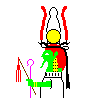

![[Hieroglyphs]](gods.gif) (Chapter 170) Osiris was worshipped in Sais as he was in all of Egypt, the only god worshipped everywhere. He was Egypt's first king, and brought the knowledge of agriculture to the people. His consort was his sister Isis. They were the children of the sky Nut, and had other brothers and sisters. One brother, Set, murdered Osiris for his kingdom, and concealed his body in a far land. Isis found the body, but Set discovered where she had hidden it and cut it into pieces which were buried throughout Egypt so Isis could not put him back together. Nevertheless, she did this, and through her efforts life returned to Osiris. The risen Osiris became king of the underworld, which was both heaven and hell to the Egyptians, where he judged the dead and gave them eternal life if they deserved it. Osiris had a tomb wherever a part had been buried (there seems to have been an excessive number of parts). His head was buried in Abydos, the center of his cult. Herodotus does not say what part was buried in Sais, but Osiris had a tomb in the temple of Neith, and his mysteries were celebrated in its precincts. The title sketch shows Osiris redivivus as he sits on his throne in the underworld, where the sun goes at night, still in his tomb wrappings, but holding the symbols of power and wearing horns and an elaborate crown that includes the sun disc. He is green like new vegetation. Osiris is identified with Dionysus, and his rites are similar. In an XVIII dynasty inscription, he is said to be "hidden of attribute in the temples." The probable reason is so Set cannot find his parts and destroy them.
(Chapter 170) Osiris was worshipped in Sais as he was in all of Egypt, the only god worshipped everywhere. He was Egypt's first king, and brought the knowledge of agriculture to the people. His consort was his sister Isis. They were the children of the sky Nut, and had other brothers and sisters. One brother, Set, murdered Osiris for his kingdom, and concealed his body in a far land. Isis found the body, but Set discovered where she had hidden it and cut it into pieces which were buried throughout Egypt so Isis could not put him back together. Nevertheless, she did this, and through her efforts life returned to Osiris. The risen Osiris became king of the underworld, which was both heaven and hell to the Egyptians, where he judged the dead and gave them eternal life if they deserved it. Osiris had a tomb wherever a part had been buried (there seems to have been an excessive number of parts). His head was buried in Abydos, the center of his cult. Herodotus does not say what part was buried in Sais, but Osiris had a tomb in the temple of Neith, and his mysteries were celebrated in its precincts. The title sketch shows Osiris redivivus as he sits on his throne in the underworld, where the sun goes at night, still in his tomb wrappings, but holding the symbols of power and wearing horns and an elaborate crown that includes the sun disc. He is green like new vegetation. Osiris is identified with Dionysus, and his rites are similar. In an XVIII dynasty inscription, he is said to be "hidden of attribute in the temples." The probable reason is so Set cannot find his parts and destroy them.
![[Text]](h170txt.gif)
![[Vocabulary]](h170voc.gif) In the second sentence there are four perfect passive participles. Can you find them? Only one shows reduplication, but the accent on the penult is what distinguishes them. Why are perfects used? There is one verb in the perfect, for the usual reason. It describes an action that happened once in the past, but nevertheless still has a present consequence. Note how the adjective for round is derived from the word for wheel, the different words used for the wall of a house and the wall of a city, and that grave in plural becomes burial place or gravesite, referring to all the monuments that may be included. It still takes a plural verb. There are, as usual, several Ionicisms that are easy to understand.
In the second sentence there are four perfect passive participles. Can you find them? Only one shows reduplication, but the accent on the penult is what distinguishes them. Why are perfects used? There is one verb in the perfect, for the usual reason. It describes an action that happened once in the past, but nevertheless still has a present consequence. Note how the adjective for round is derived from the word for wheel, the different words used for the wall of a house and the wall of a city, and that grave in plural becomes burial place or gravesite, referring to all the monuments that may be included. It still takes a plural verb. There are, as usual, several Ionicisms that are easy to understand.
There is also in Sais the burial place of him whose name it is not permitted that I reveal in such matters, in the temple of Athena, at the back of the sanctuary all along one side of Athena's wall. Also in the sacred precincts two large stone obelisks stand, and a lake near them adorned by a stone margin made in a perfect circle, of a size, as it seemed to me, similar to that of the so-called round pond at Delos.
Return to Pharaoh
Composed by J. B. Calvert
Last revised 29 July 1999